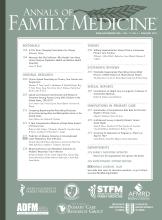Abstract
PURPOSE We aimed to determine the effects of implementing risk-stratified care for low back pain in family practice on physician’s clinical behavior, patient outcomes, and costs.
METHODS The IMPaCT Back Study (IMplementation to improve Patient Care through Targeted treatment) prospectively compared separate patient cohorts in a preintervention phase (6 months of usual care) and a postintervention phase (12 months of stratified care) in family practice, involving 64 family physicians and linked physical therapy services. A total of 1,647 adults with low back pain were invited to participate. Stratified care entailed use of a risk stratification tool to classify patients into groups at low, medium, or high risk for persistent disability and provision of risk-matched treatment. The primary outcome was 6-month change in disability as assessed with the Roland-Morris Disability Questionnaire. Process outcomes captured physician behavior change in risk-appropriate referral to physical therapy, diagnostic tests, medication prescriptions, and sickness certifications. A cost-utility analysis estimated incremental quality-adjusted life-years and back-related health care costs. Analysis was by intention to treat.
RESULTS The 922 patients studied (368 in the preintervention phase and 554 in the postintervention phase) had comparable baseline characteristics. At 6 months follow-up, stratified care had a small but significant benefit relative to usual care as seen from a mean difference in Roland-Morris Disability Questionnaire scores of 0.7 (95% CI, 0.1–1.4), with a large, clinically important difference in the high risk group of 2.3 (95% CI, 0.8–3.9). Mean time off work was 50% shorter (4 vs 8 days, P = .03) and the proportion of patients given sickness certifications was 30% lower (9% vs 15%, P = .03) in the postintervention cohort. Health care cost savings were also observed.
CONCLUSIONS Stratified care for back pain implemented in family practice leads to significant improvements in patient disability outcomes and a halving in time off work, without increasing health care costs. Wider implementation is recommended.
- low back pain
- stratified care
- subgroups
- family practice
- primary care
- quality improvement
- screening
- practice-based research
- Received for publication June 4, 2013.
- Revision received October 31, 2013.
- Accepted for publication December 14, 2013.
- © 2014 Annals of Family Medicine, Inc.







